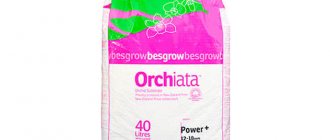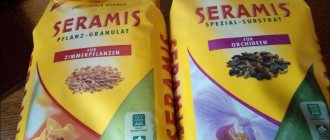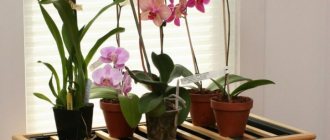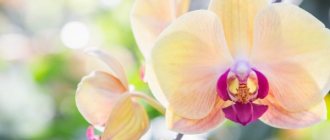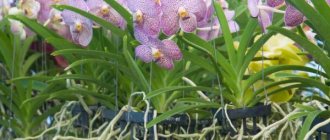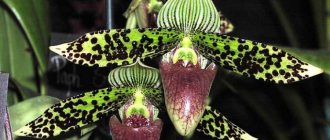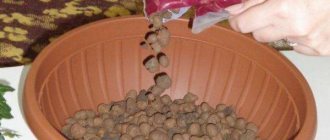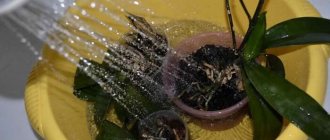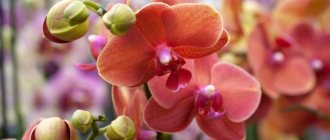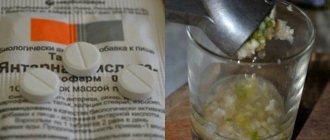Phalaenopsis with “open” roots: specifics of cultivation
When transferring phalaenopsis from an old substrate to keeping it in a plug or with a bare root system, the orchid has difficulty adapting - it loses leaf turgor, and its substrate roots may dry out.
Only the new leaves and roots that the phalaenopsis will grow will feel good and familiar.
Not all orchids of this species like to grow in glass vases without a substrate.
Here it is important to guess the desire of the flower so as not to dry out the plant. When growing on a block with open roots, moisten the roots every other day, or every day depending on air humidity
Of course, caring for them is problematic: frequent watering, the inability to leave for a while, but the roots of such orchids are healthy and they grow well
When growing on a block with bare roots, moisten the roots every other day, or every day, depending on air humidity. Of course, caring for it is problematic: frequent watering, the inability to leave for a while, but the roots of such orchids are healthy and grow well.
Components for different types of flower
To choose the right soil for orchids, you need to know the characteristics of plant growth in nature.
"Dendrobium"
Dendrobium is a type of orchid that belongs to epiphytes. In nature, dendrobiums attach to trees, but do not harm them as parasites; they receive nutrition from the air.
The substrate for growing at home is pine bark and small pieces of charcoal.
"Wanda"
The "Vanda" variety does not require a substrate. The plant does well in a glass pot or plastic container with many holes. Sometimes oak bark is used for “Vanda”.
"Cattleya"
In nature, Cattleya grows in rock crevices or on mossy trees. She needs a nutritious environment. The main components for the variety are:
- sphagnum moss;
- pine bark.
"Miltonia"
The Miltonia variety requires aerated and moist soil. Suitable substrate made from small pieces:
- pine bark;
- dry sphagnum;
- charcoal;
- peat crumbs.
All ingredients are taken in equal proportions.
“Miltonia” does not mind when fertile turf or leaf soil is added to the composition.
"Phalaenopsis"
The main components for the soil of the Phalaenopsis variety:
- crushed pine bark (50%);
- sphagnum moss (20%);
- forest fern roots (20%).
Review: Soil for orchids ZeoFlora - Feeding for home beauties - orchids.
Good day to everyone, dear readers! I like indoor plants, but I take care of them somehow spontaneously, so the only plants left are those with which there was mutual love and a desire to see each other further) One of these plants includes orchids. Now I have six of them and they are in dormant mode, that is, they do not bloom. Usually on New Year's Eve they begin to delight with their beauty.
To care for them, for several years I purchased fertilizers and certain types of soil that suited me, but I decided to try something new for myself - a new moisture-retaining soil. What motivated me was that, having once left for two weeks, upon arrival, two dead flowers were waiting for me (those on whom I left them did not water them and from the heat of the radiators they dried out - it was not possible to restore them), so the peculiarity of the soil is that it retains moisture for me was important.
The soil is in the form of medium-sized balls, reminiscent of those that are placed on the bottom of flower pots (expanded clay). According to the manufacturer, the soil saturates the plant with microelements and retains moisture.
I admit that at first I was afraid to plant my pets in “stones”, somehow it didn’t fit that they would get everything they needed from the stones, so I planted two orchids, filling them halfway, and only added a little to one. On the packaging there is information that you need to add from 20 to 90 percent of the total soil mass.
The packaging looks standard – it’s a bag with the contents – stones.
When watering, this soil makes hissing sounds) Immediately after replanting, I noticed that one orchid’s existing green sprouts began to dry out. Of course, this upset me, but I did not return them to their previous soil. As a result, the old roots dried out and new ones began to appear - dark green and juicy. On another plant a bud emerged, a future flower.
I’ll add that during this period I also spray the top of the leaf with liquid fertilizer once every two weeks. I won’t say that this soil is somehow better than the previous one (you can read a review about it here), in theory, the usual one with liquid fertilizer was enough for me. Although with “Zeo flora” and plus liquid fertilizer I noticed faster growth and new dark roots, I had never seen anything like this before. As for moisture retention, I can’t say that it is obvious: I placed the pots in a bowl of water to soak them in moisture for 20-30 minutes , but the additive still dried out quite quickly, although now is the heating period and it’s warm on the windowsill where the flowers are. Maybe in the summer season the moisture will linger longer.
It is in vain that the manufacturer called it “soil”, because in essence it is just a fertilizer or soil improver, and not an independent soil. For those who want fast growth and flowering, “Zeo flora” will definitely come in handy. The cost of the package is about 260 rubles.
Soil composition requirements
Many amateur gardeners are interested in whether it is possible to use ordinary soil to grow beautiful orchids. The soil for such plants is different from all other soil mixtures to which gardeners are accustomed. Epiphytes are not recommended to be planted in ordinary soil taken from a flower bed or garden. They will need to create a substrate that is ideal for the unusual growth method. Below we describe the main components of the soil mixture for an orchid, as well as their preparation before planting the plant in a pot.
Substrate for orchids
You can purchase individual soil components at the store or assemble it yourself. In fact, it is not difficult to assemble the substrate with your own hands, the main thing is desire and adherence to basic rules.
Bark
Orchids are planted in a substrate that includes the bark of any tree or even shrub. However, most tree species have a relatively thin and strong shell, which is not very suitable for an orchid. For phalaenopsis soil, it is best to use porous but thick bark. It is this type that can well absorb and retain more air and moisture, which are needed for breathing and nourishing the roots of the orchid, improving its color.
Note! It is best to use pine bark from mature trees that are more than 50 years old; they have a shell 8-12 mm thick in the lower part of the trunk.
Places where you can collect bark for an orchid are absolutely accessible to everyone. This is a pine forest, park or square where these trees are planted. If there is a sawmill nearby, you can get the bark there.
Note! Stripping bark from living trees is strictly prohibited. Mechanical damage can be the main reason pests enter an open “wound” of a tree. In addition, fresh bark contains many resinous substances that are harmful to the orchid.
When harvesting bark, it is necessary to cut the wood.
Land for an orchid
Coconut fiber
Coconut base is made from the shell and outer husk of the coconut. The substrate component is well suited for growing orchids for the following reasons:
- it is considered completely organic, without foreign harmful inclusions, which makes it also environmentally friendly;
- easy to use and relatively inexpensive;
- can be used as an independent base, as well as as a component for preparing a substrate;
- Coconut fibers are characterized by good moisture holding capacity and aeration - the necessary components for orchid growth.
Important! The acidity of the soil based on such fiber is neutral, that is, a completely comfortable environment is created for the full development of roots.
You can use coconut shavings in their pure form, but it will be more justified for large-sized orchids. Small flowers require a substrate made from small fractions of coconut shells.
Charcoal
In addition to its pronounced drainage effect, charcoal will undoubtedly help balance the acidity of the soil for the orchid. But, like any other adsorbent, coal will accumulate an extremely large amount of salts after some time. After this, it will not bring anything useful to the plant. Therefore, it will need to be replaced with a new one from time to time.
You can pour it in small quantities and only into the substrate for those flowers that do not need constant feeding with fertilizers. If you add a lot of charcoal to a flowerpot with an orchid, there is a risk of disturbing the salt balance.
For your information! You can use standard charcoal from a burned fire. Be sure to rinse it well, dry it and grind it. You should get pieces measuring 4-5 mm (no more than 1 cm).
Minerals
These components are added to the substrate along with nutritional supplements, which makes it possible to compensate for the lack of nutrients in the main micro- and macroelements of the soil mixture. Minerals also prevent the accumulation of various salts in the soil, and also help maintain a certain acidity of the entire substrate. Orchid nutrition includes nitrogen, potassium, phosphorus, boron and magnesium, iron and sulfur. In a minimum dosage, the orchid needs fertilizing, which contains zinc, chlorine, silicon, sulfur, manganese and other minerals.
Components of an orchid substrate
Additionally, you can use the following components for the substrate: fern roots, foam glass, sphagnum moss. Many gardeners add pieces of polystyrene foam, but it is better not to do this.
If you need to add fern roots, you can dig them up yourself. Only large parts of the root system should be used. It is worth remembering that the larger the above-ground part of the plant, the wider the root system, which is what is needed. It is recommended to rinse the roots well with warm water, dry them, and chop them into pieces no longer than 2 cm.
Note! If you want to add sphagnum moss to a flowerpot with an orchid, you can collect it in the spring after the snow has melted in the lowlands. This component is characterized by bactericidal properties and perfectly accumulates water. It is used only in dry and fresh form.
Foam glass is a foamed base that has excellent moisture holding capacity. The unusual, spongy structure of the substrate allows water to accumulate in the micropores of the soil and evaporate through the macropores. This allows oxygen to penetrate the plant's root system, nourishing them thoroughly.
Pros and cons of the finished substrate
What is good about purchased substrate:
- Convenient packaging - measured in liters, suitable for calculating how many orchids need to be replanted.
- There are ready-made mixtures that do not require additional moss or drainage.
- There are soils that are additionally enriched with minerals. This makes it possible not to feed the plants additionally.
- Manufacturers produce different formulations: complex and monocomponent, depending on the type of epiphyte and the individual preferences of its owner.
Among the disadvantages are the average quality of some brands, where production allows:
- uneven fraction of bark and expanded clay;
- inclusions of debris or debris;
- parasite infection.
There are packagings where it is impossible for the buyer to examine the condition of the product, and when opened, mold, mustiness and other imperfections are revealed.
Store soil
The easiest way to provide acceptable conditions for orchids is to use store-bought soil mixtures. Let's tell you more about them.
What should be included
Ready-made substrates typically contain the following ingredients:
- pine bark;
- wood chips;
- charcoal lumps;
- peat;
- sphagnum moss.
Soil for phalaenopsis must be sterilized and packaged in plastic bags or buckets with a capacity of 1 to 5 liters.
Definition of quality
A good composition contains mainly bark - its fraction is small, from 10 to 30 mm. The pieces should remain strong. If they fall apart in your hands, then this is considered a marriage.
Charcoal is taken of medium size (up to 20 mm). He should also be hard and unbreakable.
Moss is used exclusively dry - it is present in the form of small shreds.
A substrate of proper quality is generally crumbly, does not form a lump when compressed, and never contains inclusions with traces of mold.
The smell of dampness is also unacceptable - if there is one, then planting an orchid in such soil is simply dangerous.
How to choose
Not all store-bought mixtures will allow you to grow healthy phalaenopsis, so be very responsible when purchasing them.
First of all, make sure that the soil is intended specifically for orchids - this is indicated by a special mark.
Next, read the list of ingredients - it is advisable that it coincides as much as possible with the above.
Check the container for leaks. The substrate is sterilized, and therefore even a small hole in the packaging can lead to infection by bacteria and pests.
The presence of fertilizers in the mixture is not mandatory. The mineral-enriched option is more suitable for young plants.
Important: if polystyrene foam is included in the substrate, there is nothing wrong with that, but its presence does not eliminate the need to put a drainage layer in the pot.
Choosing the best: purchased options
When deciding which soil is best to buy for a phalaenopsis orchid, many experience difficulties. This is not surprising, because the assortment in stores is very large. However, there are several well-established manufacturers that you can give preference to.
“Garden of Miracles” is a purely Russian finished product, produced by Fart MNPP for many years. It is versatile and suitable for many types of orchids, including phalaenopsis. The soil is sold in 2.5 liter bags. For one unit you will have to pay only 95 rubles.
“Flower happiness”, in principle, is ideal for indoor epiphytes, but has one drawback - the substrate contains larch bark. You will have to add pine yourself - this is a direct recommendation from the manufacturer. The price of the mixture, however, is low - just over 70 rubles for 2.5 liters.
Judging by the reviews, the soil called Peter Peat is very good. It is highly nutritious and allows you to confidently grow most epiphytic orchids. The ingredients included in it ensure proper breathability and moisture retention. The optimal choice for transplantation. It is very inexpensive - 50 rubles for 2.5 liters.
Pokon (“Pokon”) is another high-quality ready-made substrate. On the one hand, it does not allow water to stagnate, and on the other, it does not block air access to the orchid’s root system. The manufacturer himself emphasizes that his product contains only natural ingredients:
- top quality bark;
- lime;
- complex feeding.
The volume of the latter is sufficient so that the plant does not need additional fertilizer over the next 2 months. The only disadvantage of soil should be considered its high price. For 2.5 liters you will need to pay approximately 650 rubles.
Compo Sana (“Compo Sana”) is another very expensive German substrate. The soil mainly contains high-moor peat and bark. Auxiliary ingredients are as follows:
- lime;
- minerals.
Many users find that this mixture cannot be considered ready for use due to its high peat content. It is recommended to mix it with homemade soil in a ratio of 1 to 3. The price of 5 liters is approximately 380 rubles.
Probably the best choice in our country is “Effect Bio”. This substrate ideally combines reasonable price and high quality. The finished mixture is clean and dry.
In addition to Angora pine bark, it contains:
- sphagnum;
- vermicompost.
The environmental friendliness of the soil is confirmed by a certificate of conformity, and therefore it is suitable for most epiphytic orchids. The substrate is suitable for transplanting, growing young orchids and even children. A 2-liter bag will cost 300 rubles.
This, of course, is not a complete review, and therefore, if you come across an unfamiliar brand of soil for phalaenopsis, be sure to read the reviews about it.
Top best soils
The most affordable soils can be considered (from 59 rubles per 1 liter):
- Geolia;
- "Black Gold";
- "Flower Happiness";
- "Fasco";
- "Ambulance".
“Living World” also has an affordable price, but is not found in all cities of Russia. The same can be said about the Black Gold soil. In terms of composition, Seramis is most praised (from 571 rubles for 5 liters), although its mixture contains a lot of fine fractions. Kekkila “Ceoflora” and Geolia have proven themselves well on the flower growers’ forums.
The most negative reviews are found among users of the “Ambulance” soil, where both mealybugs and fungus gnats were found in some of the packs.
Soil options for orchids - DIY composition
Soil for cacti: basic soil requirements and options at home
Which substrate for orchids to choose with your own hands depends on the conditions under which the plants are kept, the temperature and humidity in the room, as well as the capabilities of the grower. Here are the most common compositions:
Option No. 1 – for rooms with air humidity of about 60%:
- pine bark - 5 parts;
- polystyrene foam - 1.5-2 parts;
- expanded clay – 1.5-2 parts;
- sphagnum and/or peat – 1 part;
- charcoal - 0.5 parts.
Option No. 2 – for rooms with air humidity of about 80%:
- bark - 9.5 parts;
- charcoal - 0.5 parts.
Option No. 3 – for rooms with air humidity of about 50%:
- pine bark - 5 parts;
- sphagnum - 2 parts;
- charcoal - 1 part.
Self-prepared soil for orchids at home
Step-by-step cooking process:
- Sterilize all components of the mixture.
- Mix in the given proportion.
- Pour the substrate into the planting pot without compacting it.
- Place the roots loosely on the surface, lightly sprinkled with bark.
- Water the plant by immersing the pot 2/3 in water at room temperature.
At the end, you need to remove the pot from the water, allow excess moisture to drain and place in a warm, sunny place without drafts.
How to determine the quality of purchased soil
Most often, defects are not production defects, but as a result of improper storage or incorrect delivery.
Pay attention to the following points:
- The name should indicate whether the substrate is universal or intended only for epiphytic orchids. It’s good if you can purchase a substrate specifically for phalaenopsis.
- Carefully read the composition of the components. This can be verniculite, expanded clay, bark, swamp moss, chips or coconut fiber, but earthen soil is excluded.
- If the packaging is not transparent, check it by touch. The fractions inside should be no more than 3 cm. There may also be small inclusions, but this should not resemble dust or small crumbs.
Upon visual inspection, the soil is a mixture of medium and large fractions; it should not be black in color, similar to soil.
Substrate composition
The main components of the soil for orchids are pine bark, sphagnum moss, peat and coal:
- The most important component is pine bark , which supplies the roots with air and moisture. You can use the bark of spruce or other trees. It is important to remember that it intensively absorbs nitrogen; as a result, the flower may experience a deficiency of this element. Additional feeding will help correct the situation.
- An excellent environment for the development of orchids are coconut fibers , which perfectly retain moisture. They can be used alone or together with other soil components. The particle size of coconut fibers is selected in accordance with the requirements for humidity and the amount of oxygen. The advantages of the fiber are its organic origin, breathability, environmental friendliness and moisture absorption. It is absolutely harmless and does not contain pathogenic microflora.
- Young orchids need to add sphagnum moss to the soil , which is changed annually.
- Sphagnum peat is included in the soil to accumulate moisture, so its structure remains coarse-fiber. Peat must contain a minimum amount of salts.
- The share of charcoal in the soil mixture is no more than 5%. The positive quality of coal, adsorption, in this situation has a small drawback: coal will sooner or later accumulate a large amount of salts, which will negatively affect the acid-base balance of the soil. Adding coal is not recommended if the main component of the soil is bark, and the plant constantly needs mineral supplements. You can correct the situation and reduce acidity by adding dolomite flour to the soil or replacing charcoal with apple leaves, which will also help prevent the appearance of pathogenic fungi.
- To improve air circulation, vermiculite is often included in orchid soil . This mineral loosens the soil, protects against infections and drying out, and prevents caking of the soil, as a result of which roots form more evenly. The ability of vermiculite to maintain freshness in hot summers will protect the plant from temperature changes. Perlite has similar qualities.
Substrate without mold
The appearance of mold in a pot is usually caused not by the quality of the substrate, but by errors in caring for phalaenopsis. Probable causes: excess moisture, insufficient air circulation, poor lighting, low temperature and impervious heavy soil.
Prevention measures
Watering phalaenopsis should be done only after the substrate has completely dried. The interval between moisturizing depends on the time of year and the location of the orchid.
In winter, the frequency of watering is significantly reduced.
At this time, it is especially important to avoid drafts. It is necessary to select a pot for phalaenopsis based on the size of the root system, increasing the volume of the container with each subsequent replanting
It is necessary to select a pot for phalaenopsis based on the size of the root system, increasing the volume of the container with each subsequent replanting.
Orchids need to be provided with good lighting and ventilation - fresh air circulation prevents the formation of mold. Do not confuse adequate ventilation with drafts.
Problem solving
When mold appears, it is necessary to reconsider the conditions under which the orchid is kept.
Procedure:
- Remove affected soil components.
- Add a new substrate with the addition of perlite, activated charcoal and charcoal.
- Spray the ground part of the orchid with Fundazol. The composition of the solution is 2 g of the drug per 2 liters of water.
If the roots are damaged, then it is necessary to replant the phalaenopsis in the spring after flowering. Until this time, watering is noticeably reduced.
During transplantation, the root system must be disinfected - treatment with a solution of potassium permanganate will do.
Before reusing the pot, the container must be treated with a fungicide.
Novice gardeners sometimes mistake limescale deposits for mold, which can form due to the use of hard water for irrigation.
The substrate for phalaenopsis orchids is significantly different from the usual soil for planting indoor flowers. And the tasks assigned to him are completely different. By and large, the components of the substrate should serve as a good support for the orchid, provide aeration of the roots and gradually release moisture accumulated after watering.
What substrate for phalaenopsis do you prefer? What proportions do you follow when mixing the components, or do you buy ready-made soil? Please tell readers about your experience growing indoor orchids.
Substrate processing
Before mixing soil components, they should be washed and disinfected.
How and why to sterilize and rinse?
Disinfection and washing of soil substrates is carried out in order to destroy insect eggs and larvae. Resin is washed out of pine bark, and tannins are washed out of oak bark.
How to disinfect?
To disinfect the bark:
- cut into pieces 1.5-2 cm;
- boil for an hour;
- dry in the oven at 100 degrees.
Sphagnum moss and fern roots:
- remove leaves and sticks;
- rinse under running water and add boiling water;
- let cool and dry well.
Experienced gardeners advise treating any soil (purchased or prepared) with a weak solution of potassium permanganate before planting. The substrate is spilled with potassium permanganate and dried. Immediately before planting, moisten.
Soil for phalaenopsis - basic requirements
A high-quality substrate for phalaenopsis should be:
- light and moisture-absorbing;
- do not interfere with the natural circulation of air around the roots;
- provide looseness;
- have the ability to retain nutrients;
- have an acidity level of 5.5 to 6.5 pH;
- dry in 3 days;
- let in enough light.
If phalaenopsis is grown in a basket or on a block, when the risk of soil drying out is high, the composition is supplemented with components that retain moisture for a long time. Options include bog moss, fern roots and coconut chips.
When purchasing or preparing soil, take into account the individual conditions of keeping phalaenopsis
The higher the illumination and the longer the daylight hours, the faster the metabolic processes in the orchid go, the more it grows green mass and absorbs water.
If the phalaenopsis is in a warm, sunny place where the humidity does not exceed 40%, then it will feel great in soil with the addition of moss and a small amount of peat.
For dark windows that are obscured by trees or houses, the substrate should be airy and less moisture-intensive
The orchid here grows when the sun hits it. She has a slow metabolism, and the moisture in the substrate takes a long time to absorb.
What can be used for the substrate?
Traditional soil compositions for Phalaenopsis orchids are made up of the following materials:
- Pine bark;
- Sphagnum moss;
- Fern roots;
- Coconut fiber;
- Leavening agents.
Pine bark usually forms the basis of commercial orchid soils. It does not rot easily, so it serves without collapsing for a long time. Dry pine bark remains moist for a long time after watering and serves as a source of water for the plant. You can also use crushed pine cones.
The soil usually contains dry sphagnum moss. This is the main moisture-absorbing material. It also prevents the proliferation of putrefactive bacteria, which has a beneficial effect on the root system of the plant.
Dry and crushed fern roots and coconut fiber are added to the substrate to maintain its looseness. Dry fern roots contain many substances that can serve as food for the Phalaenopsis orchid. A substrate with fern roots and coconut fiber can last for several years without caking.
To prevent caking, various baking powders are added to the soil for phalaenopsis . Usually these are small expanded clay or pieces of foam. You can also use other materials: pebbles or broken bricks, some minerals and rocks, charcoal. How to make soil for phalaenopsis with your own hands, watch the video:
Soil composition
This product has high moisture capacity. Moisture, penetrating into the pores of the granules, is contained there without harming the plants. The granulate releases as much water as the orchid requires, without having a detrimental effect on the roots of the flower.
It is also important that, due to their shape, the granules allow oxygen to pass through, which is no less important for the development of the plant. It is safe for humans and animals
The Zeoflora product has sorption and cation exchange properties. The composition contains active silicon, which provides the necessary conditions for the development of the root system of the flower, and also develops its resistance to stress. Nitrogen and potassium contained in the composition also have a positive effect on the condition of the plant. The use of soil rich in useful microelements helps reduce the amount of fertilizing.
Why is it important to plant in the best substrate?
To choose the right soil, you need to understand how it differs from soil or soil, for example:
- The earth is a loose mineral covering containing all life on the planet.
- Soil is the fertile component of the earth with deposits from plant and animal organisms. This is a natural place for plants to grow.
Soil is both a mineral natural component of the earth and artificially created for gardening. It contains a lot of organic matter that is beneficial for plants.- Substrate is an artificial nutrient medium for seedlings, which may not contain soil. Literally, this is Lat. sub - under and stratum - layer - base, litter (for example, bark, peat). The main task is to supply the plant with nutrients. Thanks to the substrate, the plant receives air.
In fact, these concepts are confused in flower shops. The purchased substrate may contain soil . Ordinary soil is not suitable for phalaenopsis, since the plant does not need soil.
Based on the conditions of its growth in its homeland, it only requires a place to establish roots. Often the plant simply wraps its roots around the tree and receives moisture from under the bark.
general description
Zeoflora (ZeoFlora) is a ready-to-use soil that is suitable for growing flowering indoor plants, incl. for species of the orchid family.
It has sorbing and cation exchange properties and is suitable for growing orchids both using drainage and in a closed system.
It is characterized by an increased ability to retain moisture, which accumulates inside the granules and is consumed by flower roots as needed, giving away as much water as required.
Release forms
The substrate for orchids is available in granular form in packages of 2.5 - 5.0 liters. The diameter of the granules varies from 0.5 to 0.9 mm. The color is light brown.
Cost - 330 rubles for 2.5 liters.
Compound
The granular soil mixture consists of a natural material - zeolite, which has undergone a firing procedure under high temperatures.
It contains additives important for the health of flowers:
- silicon, necessary for flower crops for proper development of the root system and resistance to external factors;
- nitrogen, which acts as a source of active formation of green mass and abundant flowering;
- potassium, which ensures intensive shoot growth.
Advantages
- The air permeability of individual granules saturates plant roots with oxygen, which is important for their full development.
- The accumulation of water in the granular structure of the soil mixture protects the root system of home flowers from waterlogging, provides a dosed supply of moisture as required and reduces the need for frequent watering.
- The sterility of the granulate creates reliable protection against the ingress of pathogenic microflora and protects orchids from the appearance of infectious diseases and pest damage.
- The rich mineral composition acts as a source of consumption of orchid substances useful for development and replaces other feedings.
- The soil is non-toxic and absolutely safe for humans and animals.
- Does not require disposal after the death of the plant contained in it. We will use it more than once. It retains its beneficial qualities for a long time and can be reused after preliminary calcination in the oven.
- Simplifies planting and subsequent care of orchids
Components used
Let's consider what role the components play in the composition of the substrate.
Pine bark
Pine bark is not natural to the orchid family. But it allows moisture to be evenly distributed and ensures maximum air flow.
When used, mandatory heat treatment is required to remove insects and to wash out the resin.
Oak bark
Performs the same functions as pine bark. During heat treatment, tannins are washed out.
To prepare it yourself, take bark from dead trees. The bark is removed without mold, rot or insect damage.
Peat
Peat promotes the rooting of exotic plants, makes the substrate loose and provides additional nutrition to the plant. Peat can protect the plant from fungal diseases. A large amount of it increases the acidity of the soil - dolomite flour is added to the substrate to reduce acidity.
Coconut fiber
The fibrous structure of coconut fiber allows the soil to not cake, maintain breathability and lightness.
Expanded clay
Light and porous expanded clay is obtained by firing clay and is used for drainage , laying it in a layer on the bottom of the pot. It ensures unhindered drainage of excess water from the roots.
Vermiculite
A mineral with a layered structure. It retains moisture inside the substrate and allows you to increase the time between waterings. Also used as drainage.
Sphagnum moss
Moss is one of the basic components of orchid substrates. When watering, it retains salts contained in hard water. Sphagnum imparts lightness and looseness to the soil, which is necessary for the delicate roots of the plant.
Swamp moss is an ambulance for orchids when the roots rot or dry out.
Charcoal
Thanks to the sorbent and bactericidal properties of charcoal, moisture does not stagnate in the pot, and microbes and fungi do not harm plant roots.
Activated carbon
In the form of a fine powder, activated carbon is used to treat cuts on orchids as a bactericidal agent .
Natural cork fiber
Cork fiber is used to improve the aeration of the substrate.
Pine cones
Pine cones complement the pine bark. They are broken into small pieces. Heat treatment is required before use.
Humus
Humus as a component of the soil mixture is used in substrates for orchids very rarely and in small quantities. It provides additional nutrition to the roots of the plant.
A large amount of humus makes the substrate dense, reducing the looseness and breathability of the mixture.
Perlite
Perlite is a rock of volcanic origin. Used as drainage.
Roots of Osmunda fern
The Osmunda fern is a protected species. It is replaced with pine bark or the roots of ferns of unprotected species are used. Soil with fern roots does not require additional feeding. In a large number of roots, moisture capacity increases, which orchid roots “don’t like.”
If there is excess moisture, the fern roots quickly rot and require replacement of the substrate.
From floriculture practice: Cattleya orchids “welcome” the roots of the fern in the substrate. "Phalaenopsis" "do not like" it.
What does the substrate for orchids consist of?
The substrate for orchids can consist of different fillers, I will talk about them in more detail below. But when choosing a preparation in a store or assembling it yourself, it is worth remembering the main tasks that the mixture should solve:
- Good at absorbing moisture. This is necessary for the uniform release of water to the plant and the removal of excess liquid.
- Dry quickly to prevent roots from rotting.
- Allow enough air to keep conditions close to natural.
- Saturate the environment with nutrients.
Stores often sell ready-made bark-based mixtures for orchids. They meet basic requirements and are used successfully by many breeders. The main risk is that the substrate may cake and deteriorate during storage. Also, the industrial harvesting method is not capable of ensuring a sufficiently thorough selection of bark, so the set will contain pieces of different quality.
Orchid bark
The main substrate filler for orchids is bark. Pine is most often used - it is light, absorbs moisture well, dries quickly and is widely available. It's easy to find and prepare. However, you can also find mixtures based on other types: spruce, larch, oak bark. The main thing here is the correct collection and processing of the material.
So what kind of bark do you need? If we talk about conifers, then it is best to collect bark from already dead, dried trees, so it will contain less resin. It is imperative to choose areas that are not damaged by the sun, rot, or pests. For adult orchids, the particle size needed is approximately one centimeter long and wide.
Important components - moss and coal
However, bark for orchids, although the main one, is not the only filler needed. If you are using ready-made substrates, make sure they contain other elements as well. If necessary, add them separately. The most basic components are considered to be the following:
- Sphagnum moss,
- Charcoal.
Sphagnum is the most common moss in Russia. For growing orchids it is used both live and dry. Thanks to its structure, it provides sufficient ventilation of the roots. It is also capable of absorbing large amounts of moisture, performing two functions at once: it retains water and evenly releases it to the plant, and also protects aerial roots from rotting.
In addition, mosses contain a large amount of nutrients needed by orchids. In addition to sphagnum, you can use other types, for example, cuckoo flax. The main thing to remember is that dry mosses decompose quickly, and therefore they need to be changed at least 2 times a year.
Charcoal - most often birch - is used as an absorbent: it absorbs harmful substances, such as excess salts. Small pieces of the same size as orchid bark are added to the pot - 1-2 cm in diameter. It is advisable to replace the coal periodically.
Other components
In addition to the main components of the substrate: pine bark, moss and charcoal, other components are sometimes added. The following additives are common in Russia:
- High peat. It is highly breathable and can absorb large amounts of moisture. However, in the future you will have to deal with excessive soil acidity and also look for additional sources of nutrients. This supplement is good for mature and strong plants.
- Cones, nut shells, and dry fern roots serve simultaneously as a leavening agent, mulch for better ventilation of the roots, and a source of useful micro- and macroelements. Exotic coconut fibers are also suitable.
- Fallen leaves, rice husks. As these components decompose, they will provide the orchid with additional nutrition.
Inorganic components
You can also add inorganic components to the mixture of orchid bark, such that they will be chemically inert, while making the substrate more loose. Some materials also retain moisture well. Most often added:
- Coarse sand - it makes the soil lighter.
- Expanded clay, perlite and vermiculite are used as additional drainage.
- Polystyrene foam and foam rubber are also great for loosening and retaining moisture.
What composition is needed?
Phalaenopsis cannot exist without bark, charcoal, moss, peat, and fern roots. The components of the soil (substrate) will help the growth of the flowering plant with useful substances. For a young orchid it is better to buy moss. The base is fresh pine bark with a small amount of resin.
To plant, the bark is ground, boiled in a water bath and thoroughly dried. Large pieces of bark should be placed in the center of the pot to reduce excess moisture (read about how to choose the right pot for phalaenopsis here). Peat for phalaenopsis should have large fibers and a low salt composition .
It is recommended not to crush fossil fuels. Charcoal adjusts the amount of incoming moisture. But after a while it collects a considerable amount of salts. Flower growers add it very carefully. When further feeding the plant, you do not need to add coal.
The best soil for phalaenopsis orchids: TOP-6 purchased options
Among all the orchid substrates offered today by the flower market, there are many worthy options. Let us highlight the offers of popular manufacturers - their product meets the requirements of flower growers about what kind of soil is needed for planting phalaenopsis orchids at home.
Orchiata
Orchiata is the bark of the New Zealand pine Pinus Radiata. The substrate is high quality and has a number of advantages over its competitors.
Arguments in favor of orchiata:
- durability - can last up to 7 years;
- breathability;
- absence of toxins and pathogens;
- balanced PH level – 5-6;
- moderate roughness – promotes root fixation;
- no sharp corners.
The manufacturer offers 5 different fractions of Orchiata. The dimensions of the bark, depending on the chosen type, are 3-25 mm.
A significant disadvantage of the substrate is its cost.
Flower happiness
Ready-to-use soil for growing orchids from Russia. The substrate with the addition of peat is balanced and contains complex fertilizers.
All components are optimized for the characteristics of orchid growth and development. The substrate does not contain pathogenic microflora. Its effectiveness has been tested and confirmed by tests
Contains:
- high peat;
- agroperlite or expanded clay drainage;
- moss;
- bark.
Convenient vacuum packaging Doy-Pack with a flat bottom. Content volume – 2.5 and 1 l. The soil is light, crumbly, good quality bark, white moss has been added.
Seramis
It is a complex that includes clay granules, balanced fertilizers and a moisture indicator. It can be used an unlimited number of times for many years.
The basis of the substrate is specially processed clay in the form of porous granules enriched with biologically significant elements - NPK
Seramis regulates the moisture level after watering. The innovative substrate is suitable for different types of orchids.
Seramis has a number of advantages that allow you to choose it:
- when replanting, it does not need to be replaced with a new one; it is enough to add the missing amount;
- over time, its compaction does not occur, the structure remains the same thanks to the smallest pores, the granules regulate the water balance,
- accumulating mineral solutions, and then gradually returning them to the ground;
- the plant can be watered once every three weeks - the humidity indicator will show when it needs to be done;
- All substances necessary for growth are contained in balanced fertilizers.
Seramis eliminates the appearance of mold and insects. The disadvantages of Seramis include its cost and limited availability. Seramis substrate is not available in all flower shops.
Bio effect
This is one of the most common substrates. It contains exclusively organic components. The most basic of them is the bark of the Angara pine.
Substrate Effect Bio is loose, light, breathable. The raw materials are processed and dried
The dolomite flour included in Effect Bio normalizes the acidity level of the soil. The presence of microorganisms in the soil increases the immunity of phalaenopsis and its resistance to stress.
Pokon
Compressed eco-briquette of flower substrate from the Dutch company Pokon.
The list of ingredients includes: coconut fiber and an effective fertilizer - azophosphate (NPK) in a ratio of 20:20:20. Acidity level pH – 5.5-7.0.
Composted soft coconut fibers make the structure of the substrate porous, quickly saturated with air
The supply of nutrients is enough for 2 months. There is no dust or weeds in the soil.
The substrate is very easy to prepare: add 3 liters of water and wait 3 minutes. The substrate is ready for use! The volume of the resulting soil is 10 liters.
Aurica Gardens
"Gardens of Aurica" presents the ideal substrate for phalaenopsis - Orchid Profi. It is a mixture of high quality pine bark, coconut fibers and shavings, charcoal and white moss (sphagnum).
The substrate does not contain peat and expanded clay, which means the risk of root rot and rapid soil salinization is minimized.
Among the advantages of the substrate “Gardens of Aurica”: affordable cost and complete composition. The contents and dimensions of the components can be seen through the transparent packaging
Ceoflora
It contains hydrous aluminosilicate of sedimentary or volcanic origin. This is a natural zeolite stone. It contains metal oxides: potassium, aluminum, silicon, iron, sodium, etc.
The acidity level is neutral, so all these elements are perfectly absorbed.
Substrate Ceoflora Looks like hard clay, has a pearlescent sheen the color of jasper, processed using special technology
The soil is long-lasting, does not compact, does not lose its structure.
How to make it yourself at home?
It is easy to prepare the substrate at home thanks to the Internet and the knowledge gained. The magnitude of the components is directly proportional to the thickness of the roots: thicker - larger.
What does it include?
The components of homemade soil are similar to store-bought ones . Includes:
- spruce or pine bark;
- moss;
- charcoal;
- peat;
- fern root.
The composition is prepared before transplantation. Do not pre-mix the soil.
Comparison with purchased
When comparing soils: from a store and your own, it is impossible to give an assessment . In the store, the proportions and rules of preparation are already strictly observed. The ingredients are natural, but the quality does not always meet expectations. You will be confident in the substrate made at home.
However, there is an obstacle - not all components are easy to obtain. The best option for phalaenopsis is a product from the store with the addition of its own components.
Advantages and disadvantages
Advantages of making homemade soil:
- budget cost;
- high and reliable quality;
- selection of components specifically for the plant variety;
- maintaining proportions.
There are fewer disadvantages of such soil, but they exist:
- Some components are difficult to obtain.
- Another drawback concerns pine bark. There is a possibility of bringing insects into the house, and the search and preparation of bark itself is a difficult process.
Where can I get the components?
Pine bark can be obtained in the forest , preferably from felled trees or near them. So the amount of resins will be less. Coal is one of the simplest components. It can be found at the site of the fire after tourists have rested.
Peat is difficult to obtain, so it can be purchased in specialized stores. Minor components for the soil are also collected from the forest.
Important! Sphagnum moss can be found in deep holes. However, you need to be careful when collecting, as there is a risk of falling 15-20 meters. Another way to get the plant is in small swamps after the snow melts in the spring. Moisture promotes moss growth. Deciduous soil is rotted leaves or a decomposed layer of old pine needles.
How to make: step-by-step instructions
To make the substrate you will need a spatula, scissors, a knife and bags . It will take some time to prepare the components:
- The moss should be soaked in water for one day and then dried.
- The bark is crushed into chips and sterilized in a steam bath for half an hour. Next - dry.
- The coal is crushed into two centimeter pieces.
Peat is also divided into small particles.- The fern root is washed in warm water, poured with boiling water and then dried.
Popular methods of preparing substrate:
- Coal and bark in a ratio of 1:5.
- Coal, moss, pine chips in a ratio of 1:2:5.
- Peat and bark in equal proportions with ⅓ of deciduous soil.
The finished soil should not be too dense.
Have you decided to buy a phalaenopsis? We recommend that you look at our articles about what care is needed after purchasing it in a store, what are the rules for watering and how often to do it, how to feed the plant, and also how to separate the baby from the peduncle, stem and root.
Which soil is not suitable at all and why
It is worth considering one important detail - the phalaenopsis orchid does not need soil, because the functionality of its roots and the method of obtaining nutrients are quite specific and differ from ordinary indoor plants.
For example, orchid bark may be a more suitable substrate than standard soil, and it can grow on a tree. But porous soil is not suitable and is not needed at all - the growth and development of phalaenopsis does not depend on the soil at all.
Why is this happening:
- The nutrition of an orchid can be considered “air”. It receives it from the outside due to photosynthesis, which occurs in all parts of the plant and its roots. That is why the flower needs a substrate that will transmit light well and a lot of air.
- Due to the spongy velamen, the adventitious root system of phalaenopsis can collect, absorb and accumulate moisture from the environment, and can collect dew and water from past rains from any surface, even bark or stones.
- Soil for orchids only secures the roots in the pot and provides a minimum level of humidity - this is the entire function of soils for phalaenopsis.
Choosing a pot for an orchid
How to take a shoot from an orchid: transplant options and examples at home
A container for an orchid is different from a pot for any other plant. The thing is that it is important for the roots to provide an unimpeded flow of air, without which the roots quickly die. They lose their natural greenish color, becoming gray, dry and brittle. Therefore, an ideal container has many large holes in the bottom and walls, and it should also transmit light.
Clay
Such dishes are not suitable for orchids. It has some significant disadvantages. First of all, plant roots easily grow to the internal porous surface. If you start to tear them off, for example, during transplantation, then their outer surface suffers, and then heals for a long time and painfully.
Clay pots for orchids
The second drawback is that there is no way to monitor what is happening inside with the roots and substrate. Opaque walls are an important disadvantage, practically negating the possible advantages.
Only flower growers with very extensive experience can afford to plant and grow orchids in ceramic pots. They can determine exactly what size drainage holes a given plant requires, the width and depth of the container to provide the required aeration and watering.
Important! If there are no other dishes, then the pot is first disinfected by calcining it in the oven.
In order to remove salt stains from the surface of the ceramic, it is immersed in acidified water, left for several hours, and then thoroughly washed without the use of detergents, which are easily absorbed into the porous walls.
The bottom of the pot and the walls must have very large drainage holes; fill it loosely with the substrate, and after watering, place it on paper napkins to remove all excess moisture.
Plastic
Such containers are practically free of disadvantages. That is why sellers in garden stores most often offer only such pots for orchids. For a beginning florist, the choice is obvious.
Plastic is inexpensive, you can choose the shade to suit your taste, it weighs very little, and does not require any special maintenance. A more expensive option is a glass pot, which has only one drawback - it is fragile and easily breaks when hit. Both glass and plastic easily transmit the much-needed sunlight to the roots; planting in them is simple and almost always gives excellent results.
Plastic pots for orchids
In general, you can take any pot, because it is not difficult to make any number of missing holes in the plastic. They are already available in sufficient quantities in specialized containers. Over time, high-quality plastic does not change its shape and color, so it lasts for a very long time.
Important! When it gets colder or warmer, the plastic walls do not overcool or overheat, allowing the orchid roots to better acclimatize.
If the roots eventually crawl through the holes and entwine the container too tightly, you can simply cut it and remove the orchid without damaging it. But still, you should carefully monitor the growth of the root system and plant the plant in a container of the appropriate size.
Properly prepared soil for phalaenopsis and a well-chosen pot are the most important conditions for the rapid acclimatization of an orchid in a new place. It is worth clarifying in advance what kind of soil is needed for an orchid of a given type and variety, so that later you can independently select its composition in relation to the existing air humidity in the room.
